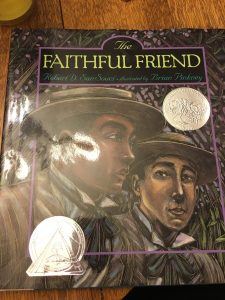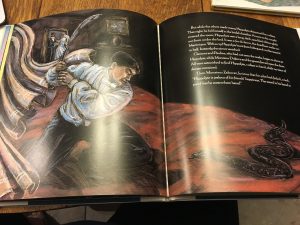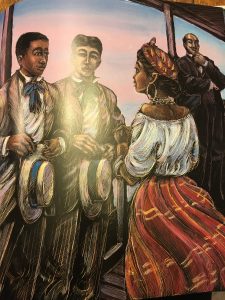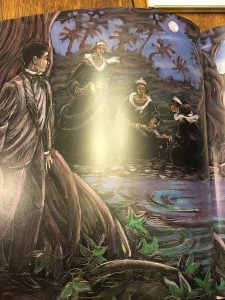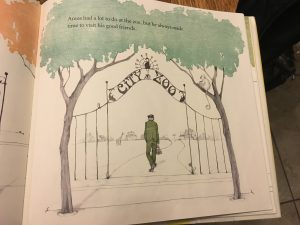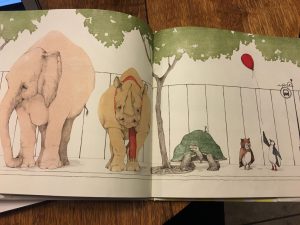Author: Britta Teckentrup
Illustrator: Britta Teckentrup
Publishing Information: Boxer Books Limited, 2013
Number of Pages: 20
Genre: Fable

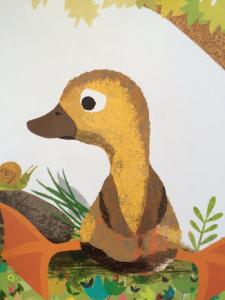
Analysis:
Clumsy Duck is a small duck who has big feet, which causes her to fall quite a bit and bump into things. Her friend, Chick, tries to do different activities with Clumsy Duck in order to see just how clumsy she is, and if there are any activities she can do without being so clumsy. In the end, Chick and Clumsy Duck discover that Clumsy Duck’s big feet are perfect for swimming very gracefully in the water.
The story starts with Clumsy Duck feeling bad about herself, because she thinks she has a flaw (her feet) that prevents her from doing things that everyone else can. However, she finds in the end that this very thing she initially viewed as a flaw was actually one of her best strengths when she used it in a different context. This can serve as both a window and a mirror for children, as it teaches them that being different can work to their advantage, and they should not feel bad about the parts of them that are different. Furthermore, the story highlights the ways in which Chick assures her friend that they will find something she is good at and tries different activities to figure out what that is. This provides a door for children to apply the same practices with their peers, rather than treating their differences in a negative way. This book definitely reflects a theme of friendship and self-acceptance that can help kids with their self-perception.
The illustrations have bright colors that help to show the hopefulness that is seen throughout the process of finding Clumsy Duck’s best use for her big feet. Also, the illustrations are not framed, allowing the reader to experience the story with the characters. I thought it was also encouraging that both Clumsy Duck and Chick were always the same size as one another throughout the story, which shows readers that they are equals (despite Clumsy Duck’s differences). Finally, I found it interesting that, for most of the story, Clumsy Duck is on the right side of the page, as this indicates the conflict she is facing within herself throughout the story.
I had the phrase “If at first you don’t succeed, try, try again” as a mantra in my head as a reflected on the storyline, because of Chick’s persistence to find something her friend would do well. This can also help children to not be discouraged by their shortcomings, and to pick themselves up and move forward. Due to the ideologies of self-acceptance, acceptance of others, and friendship that were embedded in the story, I thought this book was a very cute way to present valuable life-lessons for young children.

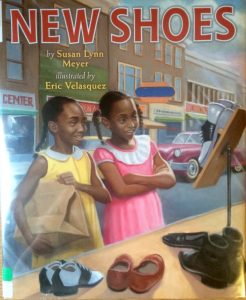 New Shoes is about a young African American girl, Ella Mae, who goes to the local shoe shop to get new shoes. But since it was during the time of Jim Crow laws Ella Mae was not allowed to try on any of the shoes because of her skin color. She found out that this was something that happened to every African American person, so Ella Mae and her best friend Charlotte decided to do something about it. They started their own shoe store by colleting old shoes and fixing them up to be as good as new. At their shoe shop everyone was able to try on all the shoes they wanted.
New Shoes is about a young African American girl, Ella Mae, who goes to the local shoe shop to get new shoes. But since it was during the time of Jim Crow laws Ella Mae was not allowed to try on any of the shoes because of her skin color. She found out that this was something that happened to every African American person, so Ella Mae and her best friend Charlotte decided to do something about it. They started their own shoe store by colleting old shoes and fixing them up to be as good as new. At their shoe shop everyone was able to try on all the shoes they wanted.
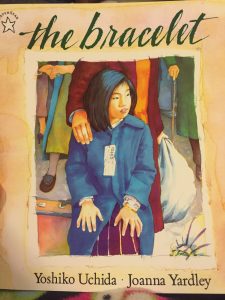
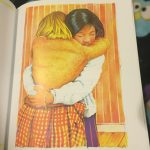
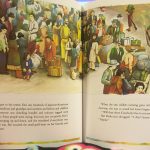
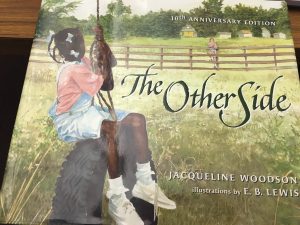
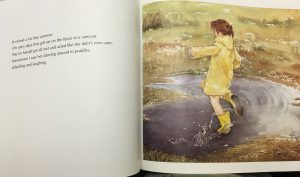 between both girls. As they continue to talk, the girls move closer together. In the story, the fence is a physical barrier between the interaction of the African American and the White populations. It also symbolically represents the barriers that people, especially African Americans, face in their lives. This title, The Other Side, also refers to another aspect of the story. This story features a main character that questions why racism and prejudice are ruling people’s lives. In this case, the character is the person on the other side of the powerful race during this time. This powerful theme carries into other aspects of life. Readers will benefit from the tolerance displayed in the story.
between both girls. As they continue to talk, the girls move closer together. In the story, the fence is a physical barrier between the interaction of the African American and the White populations. It also symbolically represents the barriers that people, especially African Americans, face in their lives. This title, The Other Side, also refers to another aspect of the story. This story features a main character that questions why racism and prejudice are ruling people’s lives. In this case, the character is the person on the other side of the powerful race during this time. This powerful theme carries into other aspects of life. Readers will benefit from the tolerance displayed in the story.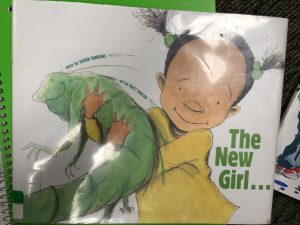
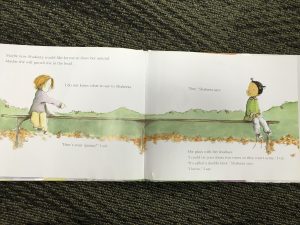
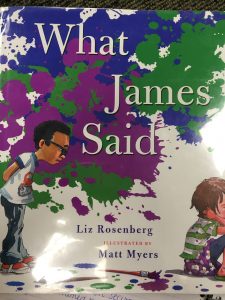
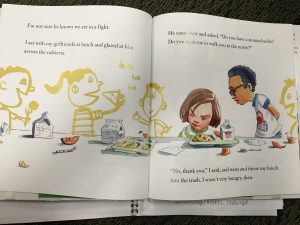 Perceptually, the images are very bright and enticing for the children. The use of faded watercolor pictures, such as in the picture below, allows the focus to remain on the narrator and James. The use of large text in certain areas allows the reader to recognize which points should be emphasized while reading the story aloud. Some of the illustrations resemble the ones that children would draw, making it very relatable for the readers. The layout of the text in relation to the pictures also allows the readers to follow the sequence very well, especially when the author is describing how each classmate heard the rumor about the narrator. Ideologically, this book shows the dangers of gossip and rumors and the effects they have on friendships. The misunderstanding during the “game of telephone” leads to the narrator’s feelings getting hurt by her best friend. Children who read this book are able to see the damage done by gossip and rumors. The ending of the book allows readers to see some things can be misunderstood and taken out of proportion. It also emphasizes the idea of friendship and its importance. The two sided story, the narrator and James’ actions, also show the different emotions when two friends are fighting. This book also gives an example of how children can solve problems with their friends. However, the way in which the narrator reacts is not recommended for children.
Perceptually, the images are very bright and enticing for the children. The use of faded watercolor pictures, such as in the picture below, allows the focus to remain on the narrator and James. The use of large text in certain areas allows the reader to recognize which points should be emphasized while reading the story aloud. Some of the illustrations resemble the ones that children would draw, making it very relatable for the readers. The layout of the text in relation to the pictures also allows the readers to follow the sequence very well, especially when the author is describing how each classmate heard the rumor about the narrator. Ideologically, this book shows the dangers of gossip and rumors and the effects they have on friendships. The misunderstanding during the “game of telephone” leads to the narrator’s feelings getting hurt by her best friend. Children who read this book are able to see the damage done by gossip and rumors. The ending of the book allows readers to see some things can be misunderstood and taken out of proportion. It also emphasizes the idea of friendship and its importance. The two sided story, the narrator and James’ actions, also show the different emotions when two friends are fighting. This book also gives an example of how children can solve problems with their friends. However, the way in which the narrator reacts is not recommended for children.![IMG_9614 [405971]](https://blogs.iwu.edu/lrbmt2016/files/2016/05/IMG_9614-405971-300x220.jpg)
![IMG_9615 [405972]](https://blogs.iwu.edu/lrbmt2016/files/2016/05/IMG_9615-405972-300x175.jpg)
![IMG_9616 [405973]](https://blogs.iwu.edu/lrbmt2016/files/2016/05/IMG_9616-405973-234x300.jpg)
![IMG_9617 [405974]](https://blogs.iwu.edu/lrbmt2016/files/2016/05/IMG_9617-405974-220x300.jpg)
